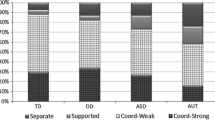Abstract
The unique characteristics of autistic children's symbolic and object play are presented and discussed in the context of a literature review covering research since 1964. Several theoretical issues are highlighted: the relationship of play in facilitating language and cognition, play as an intervention, and play as an assessment tool. Difficulties in research methodology due to pooling autistic and schizophrenic subject are raised, as well as possible difficulties inherent in ignoring severity levels within the autistic population. The appropriateness of play therapy is questioned, and evidence is presented to provide encouragement for further inquiry into the study of autistic play.
Similar content being viewed by others
References
American Psychiatric Association. (1980).Diagnostic and statistical manual of mental disorders. Washington, D.C.: Author.
Barker, R., Dembo, T., & Lewin, K. (1941). Frustration and regression: A study of young children.University of Iowa Studies in Child Welfare, 18, 386.
Clune, C., Paolella, J., & Foley, J. (1979). Free-play behavior of atypical children.Journal of Autism and Developmental Disorders, 9, 61–72.
DeMeyer, M. (1967). Toy-play behavior and use of body by autistic and normal children as reported by mothers.Psychological Reports, 21, 973–981.
DeMyer, M. (1976). The nature of the neuropsychological disability in autistic children. In E. Schopler & R. J. Reichler (Eds.),Psychopathology and child development: Research and treatment (pp. 93–114). New York: Plenum.
DeMeyer, M., Alpern, G., Barton, S., DeMeyer, W., Churchill, D., Hingtgen, J., Bryson, C., Pontius, W., & Kimberlin, C. (1972). Imitation in autistic, early schizophrenic, and non-psychotic subnormal children.Journal of Autism and Childhood Schizophrenia, 2, 264–287.
DesLauriers, A. M. (1978). Play, symbols, and the development of language. In M. Rutter & E. Schopler (Eds.),Autism (pp. 313–326). New York: Plenum.
Favell, J. (1973). Reduction of stereotypies by reinforcement of toy play.Mental Retardation, 11(4), 21–23.
Fenson, L., Kagan, J., Kearsley, R. B., & Zelazo, P. R. (1976). The developmental progession of manipulative play in the first two years.Child Development, 47, 232–236.
Hingtgen, J. N., Sanders, B. J., & DeMeyer, M. K. (1965). Shaping cooperative responses in early childhood schizophrenics. In L. Ullman & L. Krasne (Eds.),Case studies in behavior modification. New York: Holt, Rinehart & Winston.
Koegel, R. (1974). Increasing spontaneous play by suppressing self-stimulation in autistic children.Journal of Applied Behavioral Analysis, 7, 521–528.
Lowe, M. (1975). Trends in the development of representational play in infants from one to three years: An observational study.Journal of Child Psychology and Psychiatry, 16, 33–47.
McHale, S. M., & Olley, J. G. (1982). Using play to facilitate social development.Topics in Early Childhood Education, 2(3), 76–86.
Piaget, J. (1962).Play, dreams, and imitation in childhood. New York: Norton.
Rendle-Short, J., & Clancy, H. (Eds.). (1971).The autistic syndrome: Proceedings of the Sandoz Working Party on definition, nomenclature, and classification. Held in the University of Queensland, August, 1969. St. Lucia: University of Queensland Press.
Romanczyk, R. G., Diamant, C., Goren, E. R., Trunell, G., & Harris, S. L. (1975). Increasing isolate and social play in several disturbed children: Intervention and postintervention effectiveness.Journal of Autism and Childhood Schizophrenia, 5, 57–70.
Rutter, M. (1978a). Developmental issues and prognosis. In M. Rutter & E. Schopler (Eds.),Autism (pp. 497–505). New York: Plenum.
Rutter, M. (1978b). Diagnosis and definition. In M. Rutter & E. Schopler (Eds.),Autism (pp. 1–26). New York: Plenum.
Rutter, M., & Schopler, E. (Eds.). (1978).Autism. New York: Plenum.
Saltz, E., Dixon, D., & Johnson, J. (1977). Training disadvantaged preschoolers on various fantasy activities: Effects on cognitive functioning and impulse control.Child Development, 48, 367–380.
Tilton, J., & Ottinger, D. (1964). Comparison of the toy play behavior of autistic, retarded, and normal children.Psychological Reports, 15, 967–975.
Ungerer, J. A., & Sigman, M. (1981). Symbolic play and language comprehension in autistic children.Journal of the American Academy of Child Psychiatry, 20(2), 318–337.
Webster, C. D., Konstantareas, M. M., Oxman, J., & Mack J. E. (1980).Autism: New directions in research and education. New York: Pergamon Press.
Wing, L. (1978). Social, behavioral, and cognitive characteristics: An epidemiological approach. In M. Rutter & E. Schopler (Eds.),Autism (pp. 27–46). New York: Plenum.
Wing, L., Gould, J., Yeates, S., & Brierley, L. (1977). Symbolic play in severely mentally retarded and in autistic children.Journal of Child Psychology and Psychiatry, 18, 167–178.
Author information
Authors and Affiliations
Additional information
This article was written in partial fulfillment of the requirements for a master's degree in psychology at the University of Colorado at Denver under the direction of Carolyn Simmons, Ph.D. The author wishes to thank Gordon Farley, M.D., Eben Ingram, Ph.D., Carolyn Simmons, Ph.D., and Graham Sterritt, Ph.D., for their wisdom, patience, encouragement, and good humor.
Rights and permissions
About this article
Cite this article
Wulff, S.B. The symbolic and object play of children with autism: A review. J Autism Dev Disord 15, 139–148 (1985). https://doi.org/10.1007/BF01531600
Issue Date:
DOI: https://doi.org/10.1007/BF01531600




